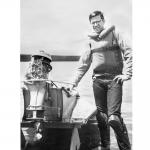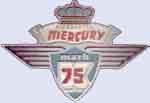Back when the idea was new to Reg. 10 racers, and the first experimenters were cobbling together their homemade water systems, Jim Hallum, as usual, went for extra sophistication. Instead for trying to spray water through a jet (or just a hole!), he came up with an agricultural spray-head (for insecticide, I suppose) that had a little spinning deflector inside that would break up the water into a nice fan-spray patter. I don't think he used it on Anzanis, but on the 125cc and other motorcycle conversions. For Anzanis, he had the exhaust valves.
Ed Karelson, whose son John (a good boat-builder and a very bright kid who would have been a force in this sport) was lost to us in a testing accident, told me about the trouble they had had with a C Yamato John was running. Ed said the water injection worked fine for getting on plane, or out of a slow corner, but that the water wouldn't clear the pipe completely for up to a lap and a half, so they quit using it. It didn't occur to me until a while later that what must have been happening was that once the flow was initiated, it would continue to siphon water up the line until the siphon was broken or the supply tank was empty. The cheap fix would have been a very small hole in the line to admit air, breaking the siphon.


 Thanks:
Thanks:  Likes:
Likes: 











Bookmarks